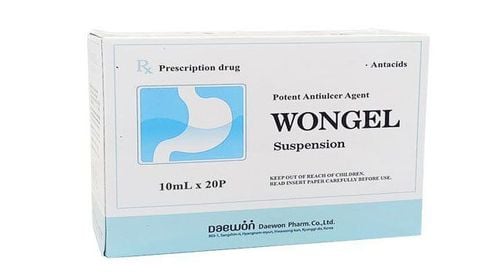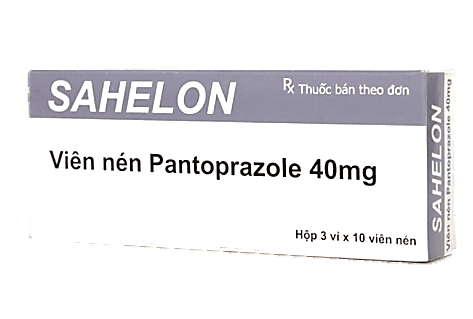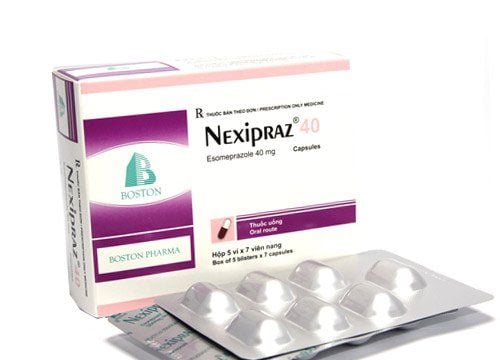This is an automatically translated article.
Sucrafar is used in the treatment of inflammatory diseases, stomach ulcers - duodenum. Learn some information about uses, dosage and precautions when using Silvasten to help patients use the drug safely and effectively.
1. What is Sucrafar?
Sucrafar belongs to the group of gastrointestinal drugs, made in the form of chewable tablets, packing box of 10 blisters x 10 tablets.
Ingredients Sucralfat 500mg in Sucrafar is an aluminum-containing gastric mucosal protector. Sucralfate's main use is to heal ulcers through a cellular defense mechanism. From there, Sucralfate forms a complex with substances such as albumin and fribinogen of the exudate that adheres to the ulcer, forming a barrier to the action of acids, pepsin, and bile salts (Sucralfate also binds to the normal mucosa of the ulcer). stomach - duodenum but the concentration will be much less than the site of the ulcer). In addition, Sucralfate also inhibits the action of pepsin, which binds to bile salts, thereby increasing the production of prostaglandin E2 and gastric mucus.
Sucralfate has more than twice the surface area covered than Sucralfate powder, so the adhesion to the mucosa is very strong. At a dose of 2g/day Sucralfate was shown to be as effective as 4g/day compared with other forms of Sucralfate.
2. Indications for taking Sucrafar
Sucrafar is used in the treatment of the following conditions:
Stomach - duodenal ulcers; Chronic gastritis; Benign gastric ulcer. Prevention of recurrence of duodenal ulcer disease and stress ulcer. Treatment of gastro-oesophageal reflux.
3. Dosage - How to take Sucrafar
Dosage and duration of taking Sucrafar will be decided by the treating doctor. Because the local protective effect of Sucralfate is only achieved when the patient uses it under the direction of the doctor.
Reference dose of Sucrafar is as follows:
Treatment of gastric and duodenal ulcers: Usual Sucrafar dose: Use 1g x 4 times/day, drink before each meal and before going to bed; or use Sucrafar dose 2g x 2 times / day, taken before breakfast and before going to bed. Each course of treatment usually lasts from 4 to 8 weeks depending on the severity of the disease until endoscopic or X-ray results show that the ulcer has completely healed. However, in case of necessity, the course of treatment can be prolonged but not more than 2 weeks. Sucrafar is often more effective when combined with histamine H2 blockers or proton pump inhibitors and antibiotics. Prevention of recurrence of peptic ulcer: The usual dose of Sucrafar is 1g x 2 times/day. The duration of treatment with Sucrafar should not exceed 6 months. Sucrafar should be combined with antibiotics to rule out the recurrence of Helicobacter pylori. Treatment of gastroesophageal reflux disease: Sucrafar usual dose is 1g x 4 times/day, taken before each main meal and at bedtime. Children over 4 years old: Use dose of Sucrafar 40-80mg/kg body weight/day divided into 4 times. The drug should be taken 1 hour before each meal and before bedtime. How to take Sucrafar:
Take Sucrafar on an empty stomach, about 1 hour before eating. Note: The above dose of Sucrafar is for reference only. The specific dose of Sucrafar will depend on your condition and disease progression. To get the right dose of Sucrafar, patients need to consult their doctor/pharmacist.
4. Contraindications to taking Sucrafar
Do not use Sucrafar in case the patient is hypersensitive to Sucralfate or to any of its ingredients.
Contraindications are absolute. This means that Sucrafar can not be used for any reason in cases of contraindications. Any decision about the dosage and how to take Sucrafar should be made by your doctor.
5. Interactions with other drugs
Do not use concomitantly with Antacid because it may affect the adhesion of Sucralfate on the mucosa. Antacid should be taken about half an hour before Sucralfate.
Sucralfate may reduce the absorption of certain drugs after concomitant use:
Cimetidine ; Ranitidine; Ciprofloxacin ; Norfloxacin; Ofloxacin; Digoxin; Warfarin ; Phenytoin; Theophylline; Tetracyclin Sucralfate can bind to proteins in food or some other drugs. Therefore, patients receiving nasogastric tube feeding should take Sucralfate separately from food and other medications.
To avoid unwanted interactions when using Sucrafar, patients should inform their doctor/pharmacist of all medicines, dietary supplements, vitamins and herbs... that are being prescribed. suitable application.
6. Side effects of Sucrafar
The most common side effect of Sucrafar is constipation. Other less common symptoms include:
Digestive system disorders such as nausea and vomiting, flatulence, dyspepsia, dry mouth; Neurological problems such as: Dizziness, headache, back pain, insomnia or drowsiness... Rarely, Sucrafar medicine causes hypersensitivity reactions such as urticaria, itching, edema, rhinitis. or laryngospasm...
When experiencing side effects of Sucrafar, please inform your doctor or ask your loved ones to take you to the nearest medical facility for timely treatment.
7. Precautions when using Sucrafar
A small amount of aluminum in Sucrafar can be absorbed from the gastrointestinal tract and eliminated by the kidneys. Therefore, there is a risk of aluminum accumulation in patients with severe renal impairment or concomitant use of other aluminum-containing drugs. Sucrafar should be used with caution in children under 4 years of age, pregnant and lactating women. Above is information about uses, dosage and precautions when using Sucrafar. To ensure health safety, patients do not arbitrarily buy Sucrafar medicine to treat at home without a doctor's/pharmacist's indication and prescription.
Please dial HOTLINE for more information or register for an appointment HERE. Download MyVinmec app to make appointments faster and to manage your bookings easily.













